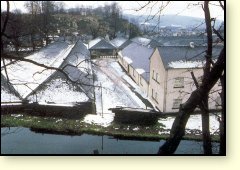
 |
|
Location: Rothes, Aberlour, Banffshire AB38 7AY
Roads: Off village main street
Phone: 01340-831215
|
The Leslies were the Earls of Rothes and claimed descent from Hungarian nobility. Soldiering Leslies served in the Swedish army, led the Covenanters and stood up as best they could to Cromwell when he gouged his way through Scotland. The ruins of the Leslies’ Castle of Rothes still sit on the hill above the town and beneath its slope you will find Glen Spey distillery.
The site is on the Rothes Burn, which is greatly favoured as a source of water - so much so that Glen Spey has to have special gadgets to help condense its spirit. Due to other distilleries further upstream discarding warm water into the flow (which is used only for cooling and never for whisky production), the burn water is not quite cold enough and after-coolers are used in addition to the condensers to convert the still-vapours. On an ecological note, distillers do not discharge hot water directly into burns and rivers, as teeming fish populations indicate; much hot water is now recycled within distilleries or cooled through heat-exchangers before being released back into streams.
James Stuart was a corn merchant with distilling interests in Macallan distillery at Craigellachie in the 1870s. He seems to have built a distilling function on to his oatmeal mill called Mills of Rothes and this expanded to become the fully fledged Glen Spey distillery that he sold to the Gilbey company of London in 1887. This was one of the first moves by a non-Scottish company towards ownership of a Scotch distillery and indicated the extent to which whisky was becoming regarded as an important international product.
The exterior of the distillery is still pleasingly Victorian with solid, weathered stone buildings. Much of the interior, too, is in period. There are two pairs of stills, the second pair being added in 1970 during rebuilding of the distillery. The stills have purifiers fitted to lighten the spirit produced. Water is taken from the Doonie Burn for the production of the distillate itself.
The Whisky
Glen Spey is a light-bodied, elegant malt with floral, exotic aromas and a silky, dry finish.
Source of water
The Doonie Burn
Of interest

Restored after 60 years’ silence, the Caperdonich distillery is now in use again. Despite using the same malt and water as neighbouring Glen Grant, its whisky is entirely different.
|
Situated just across the road from Glen Grant distillery and originally called Glen Grant No. 2, Caperdonich has been registered as a separate distillery for less than 30 years. After being built in 1897 as an additional production unit to the main distillery, it stayed in operation for a mere five years due to the surfeit of whisky in the market at the end of the century and was closed down in 1902. It remained silent for over 60 years before being revived in 1965 with its original stills – their antiquity indicated by the beautifully fashioned riveted seams – always a give-away of old-time distillery equipment. Caperdonich’s main role is as a blending whisky.